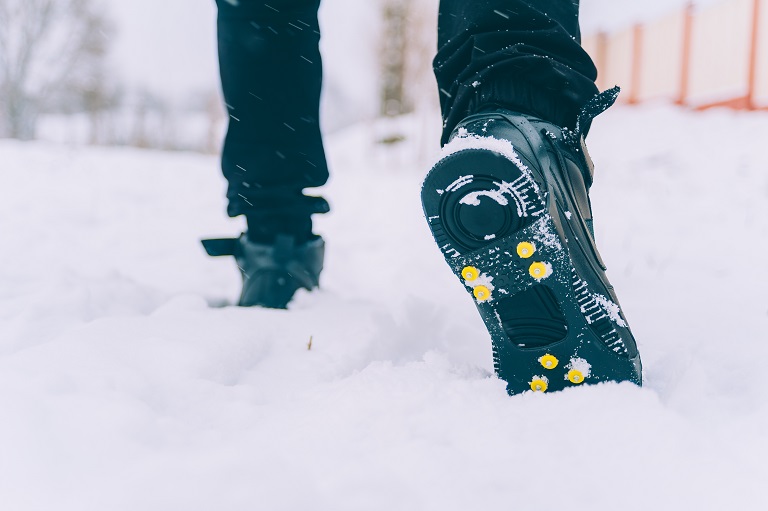5 Pros And Cons Of Ice Cleats In Winters

While it’s best to wear footwear that’s appropriate for the season, work shoes or boots don’t always cut it when it comes to walking in cold weather. People often choose ice cleats or spikes for shoes to walk on ice. Let us know more about the pros and cons of ice cleats and how to walk on ice without slip and fall.
How Much Ice Is Safe To Walk On?
Walking on ice is not recommended until it is at least 4 inches thick. The 4 inches of ice can sustain around 200 pounds, making it ideal for ice fishing, cross-country skiing, and walking.
Pros And Cons Of Ice Cleats In Winters
Pros
- Ice cleats include spikes for shoes to walk on ice. It provides traction and prevents slips and trips on icy surfaces. The bottom of a pair of ice cleats has extreme traction, as it is designed to penetrate ice and hard-packed snow.
- You don’t need to buy special winter boots for each season but can use the ice cleats on your normal shoes.
- They can be brought from winter accessory shops or ordered online.
- Ice cleats are available in various designs and sizes.
- The use of ice cleats for outdoor employees will undoubtedly reduce the number of slips, trips, and falls at your company.
Cons
- The same factor that makes ice cleats a safety tool outside makes them dangerous indoors if you do not remove them. When worn indoors on hard surfaces such as tile, ceramic, linoleum, sealed concrete, or epoxy, these cleats become a serious slip danger.
- Cleats aren’t great for mountain climbing since they’re difficult to maneuver in and the spikes aren’t long enough to provide a secure grip on an angled surface.
- Extremely rocky terrain can also be difficult on cleats, causing the spikes and housings to break. They are also hampered by deep snow.
- Ice cleats often last only one winter season if used frequently. Moreover, they make driving tedious.
- It’s also worth remembering that because steel is a good conductor of heat, ice cleats on the bottoms of boots tend to cause more heat loss from the feet while walking.
Walk On Ice- Best Traction For Walking On Ice.
Walk on ice is a salt-free traction solution that gives you an instant hold on icy, snowy surfaces. It contains naturally occurring minerals that are gentle on the eyes, skin, and paws. It has grippers and absorbers that work together to provide immediate traction. The absorbers soak the water layer formed on the surface. The grippers then use their spikes to secure the ice, allowing you to gain immediate traction.
It is safe for humans, pets, and the environment, and it works quickly regardless of the temperature or condition of the surface. It comes in a handy disposable can that can fit into a handbag or gloves compartment.
Walk on Ice Safely Beyond Ice Cleats
While ice cleats can help in certain outdoor conditions, they aren’t always practical. Many people ask, “what’s the best way to walk on ice safely without relying only on cleats?” The answer is a combination of preparation and surface treatment. Even the best shoes won’t save you if the ground beneath is slick. That’s why traction agents like Walk On Ice are such a game-changer—they work directly on the icy surface to provide grip where you need it most.
Think of it this way: ice cleats protect your feet, but Walk On Ice protects the ground. The two can complement each other, but for everyday walking—going to the mailbox, walking the dog, or heading into the office—you’ll often find that treating the surface itself is more convenient than strapping on gear every time.
How to Get Unstuck from Snow Without the Stress
Winter isn’t only about walking—sometimes the bigger challenge is your car. Almost every driver eventually has to figure out how to get unstuck from snow. The first instinct is usually to press harder on the gas pedal, but that just digs the tires in deeper. Some people try kitty litter or sand, hoping for traction, but both come with drawbacks. Kitty litter clumps, turns mushy, and can even freeze on the surface. Sand scatters too quickly and doesn’t bond with the ice, so it often blows away before it helps.
Walk On Ice works differently. Its absorbers soak up the slick water film that makes ice dangerous, while its grippers dig into the surface. When sprinkled around stuck tires, it creates an instant non-slip layer that gives your car something solid to push against. Instead of frustration, spinning tires, and a sore back from shoveling, you get a quick and practical solution. Keeping a canister in the trunk means you’re always ready for surprise snowbanks or icy driveways.
Sand for Ice Traction: Old Trick, Limited Help
One of the oldest tricks in the winter playbook is using sand for ice traction. It does have its benefits—it’s cheap, readily available, and gives you some immediate grit underfoot or under tires. But here’s the catch: sand doesn’t stay put. As soon as the wind blows, people walk over it, or cars drive across it, most of the grit is gone. It also tends to wash into drains and pile up on lawns, leaving behind a messy cleanup job come spring.
For short-term use, sand can help a little, but it’s not reliable when conditions keep changing. That’s why many homeowners and municipalities are moving toward safer, more effective traction solutions. Walk On Ice doesn’t just scatter across the surface—it locks in, absorbs moisture, and keeps working. It provides the kind of grip sand promises but rarely delivers, especially when you need stability the most.
Kitty Litter for Ice: Why It’s More Mess Than Safety
Another improvised fix many people try is kitty litter for ice. It seems logical—litter is gritty, so it should help, right? The problem is that most kitty litters are made from bentonite clay, which expands and clumps when it gets wet. On icy surfaces, that means you get sticky, slushy patches that actually make walking more dangerous. Worse, litter gets tracked indoors, leaving behind dust, residue, and a bigger mess than you started with.
Some non-clumping litters are less messy, but they still weren’t designed for outdoor traction. They don’t bond with the ice, they scatter quickly, and they won’t hold up in freezing rain. Walk On Ice, by comparison, was created specifically for this job. It stays effective even in extreme cold, provides real traction instead of a temporary grit layer, and doesn’t leave a mess behind. For people tempted to raid the litter box for a quick fix, the smarter move is to use a traction product built for icy conditions.
Conclusion
Ice cleats are helpful, but as we’ve seen, they’re not a one-size-fits-all answer to winter safety. If your goal is to truly walk on ice safely, you need more than footwear—you need reliable traction on the ground itself. Tricks like sand for ice traction or kitty litter for ice may offer a quick patch, but they’re messy, inconsistent, and often make conditions worse. And when you’re stuck in snow, knowing how to get unstuck from snow quickly can be the difference between getting on with your day and being stranded in frustration.
That’s where Walk On Ice proves its value. It’s clean, safe for pets and people, environmentally friendly, and works instantly in conditions where sand, salt, and litter fail. Whether you’re walking up icy steps, clearing a driveway, or freeing your car, it provides stability you can trust. Winter will always bring challenges—but with the right traction agent, you can face them confidently, without relying on hacks that don’t hold up.
Conclusion
Slips, trips, and falls are very common, especially in the winter. Ice and snow build up on sidewalks and, in parking lots, corridors become slick as the snow melts off people’s shoes, and day-to-day footwear may not provide adequate grip to prevent difficulties. Hence, Walk on ice is the best option for immediate traction on any surface. It will protect you and also safeguard your near ones from any slip and fall injury.
Get ready for winter with Walk On Ice instant traction on snow and ice
Other Ice Melt Products
Safe Paw
The Original and #1 Selling Pet and Child Safe Ice Melt for over 20 years. Guaranteed environmentally safe – will not harm waterways and sensitive wetlands. All products are made in the USA.

Safe Thaw
Imagine an ice melt you can put down and never worry about. It won’t harm pets, kids, and your property. That’s Safe Thaw. Unlike anything else on the market, Safe Thaw can change how winter affects our planet.



